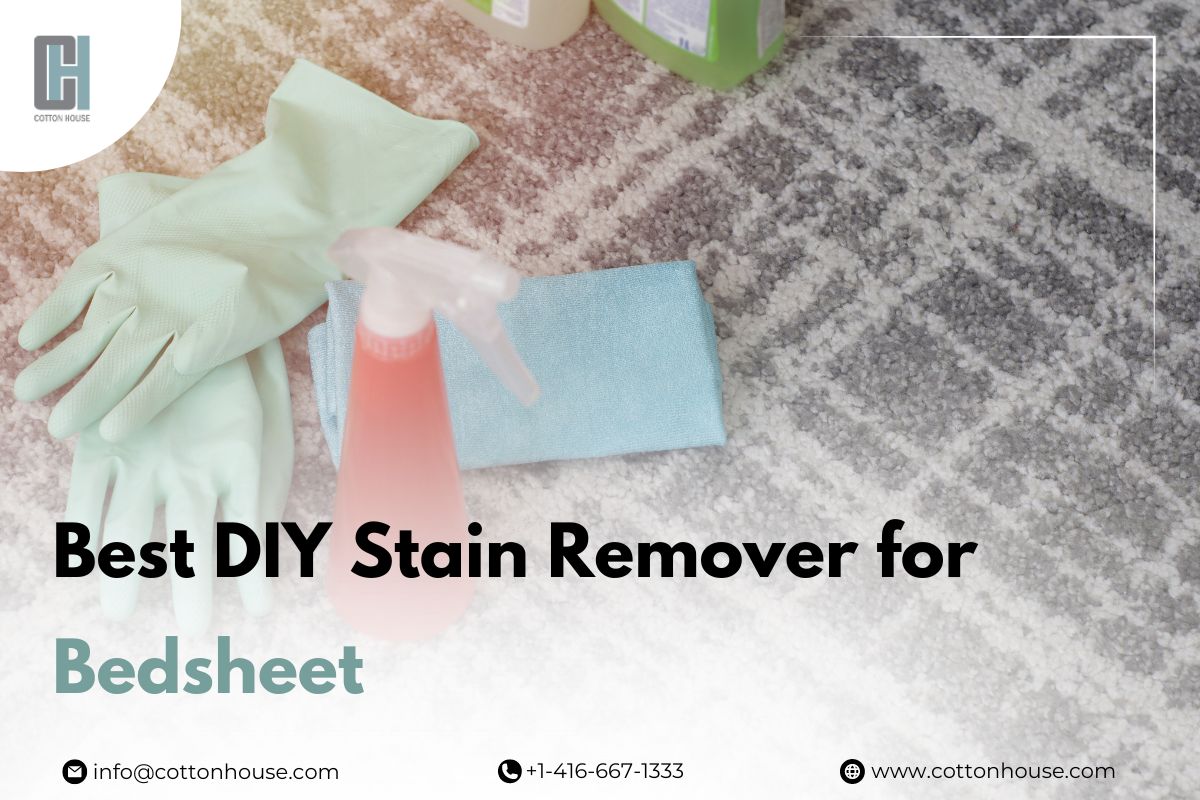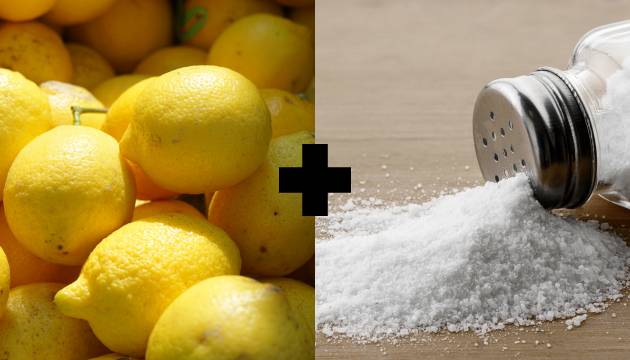
We’ve all been there. You wake up to find an unsightly stain on your bedsheet, and panic sets in. Well no need to worry about it. There’s no need to resort to costly cleaners or harsh chemicals.
This blog is here to guide you through the process of making a DIY stain remover for bed sheets. With a few common household items, you’ll create a powerful bedsheet stain remover that makes bed sheet cleaning not only effective but also affordable and eco-friendly. Let’s get into this simple yet transformative solution and get rid of stubborn stains for good.
Common Types of Stains on Bed Sheets:
Bedsheets endure a lot, from accidental spills to natural body oils, and each type of stain presents its own unique challenge. Understanding the common types of stains can help you better tackle them with the right solutions, including our DIY stain remover for bedsheets. Here are some of the most frequent culprits:
- Food and Beverage Stains: Morning coffee spills, late-night wine accidents, and breakfast in bed can all lead to stubborn stains. These stains often penetrate deeply into the fabric, making them challenging to remove.
- Body Oils and Sweat: Over time, natural body oils and sweat can build up on your bedsheets, leading to yellowing and discoloration. This is especially common in pillowcases and the areas where you sleep the most.
- Blood Stains: These can occur from minor cuts, nosebleeds, or even monthly cycles. Blood stains are notorious for being difficult to remove if not treated promptly.
- Ink and Makeup Stains: Whether it’s from jotting down notes in bed or accidentally smudging your eyeliner, ink and makeup can leave noticeable marks on your sheets.
- Grease and Oil Stains: These can come from skincare products, hair treatments, or even food. Grease and oil stains tend to cling to fabric, making them particularly stubborn.
Knowing the type of stain you’re dealing with is the first step in effective bedsheet cleaning. Each of these stains requires a different approach for optimal fabric stain removal. Thankfully, a versatile bedsheet stain remover can be created at home with a homemade stain remover solution. By using everyday household items, you can tackle these common stains effectively and keep your bedding looking fresh and clean.
So next time you find yourself faced with one of these pesky stains, remember that a DIY stain remover for bedsheets is just a few steps away. With the right knowledge and tools, you’ll master the art of fabric stain removal and extend the life of your beloved linens.
Also Read: What kind of bedding items hotels use?
Basic Ingredients for DIY Stain Removers:
Creating an effective DIY stain remover for bed sheets starts with understanding the best ingredients for tackling various stains. These common household items are powerful on their own and even more effective when combined:
- Baking Soda: This versatile powder is excellent for absorbing odors and lifting stains. It’s a gentle abrasive that can help scrub away tough marks without damaging the fabric.
- White Vinegar: Known for its natural cleaning properties, white vinegar can break down stains and neutralize odors. It’s particularly effective against alkaline stains like coffee and tea.
- Hydrogen Peroxide: A mild bleaching agent that can help lighten stains and disinfect the fabric. It’s great for blood and other protein-based stains.
- Lemon Juice: The acidity in lemon juice helps break down stains and brighten whites. It’s especially useful for removing rust and other mineral-based stains.
- Liquid Dish Soap: This ingredient cuts through grease and oil stains effectively. It’s a staple in many homemade stain remover recipes.
- Essential Oils: While not necessary for stain removal, essential oils like lavender or tea tree oil can add a pleasant scent and additional antibacterial properties.
- Cornstarch: Effective for absorbing grease and oil stains before they set in. It can also be used as a mild abrasive for scrubbing.
- Borax: An all-purpose cleaner and deodorizer that enhances the stain-fighting power of other ingredients.
5 Best Stain Remover Recipes:
Now that we know the essential ingredients, let’s dive into five of the best DIY stain remover recipes. These homemade stain removers are easy to make and effective for a variety of stains.
1. Baking Soda and Vinegar Paste:

Ingredients:
- 1/2 cup baking soda
- 1/4 cup white vinegar
- 1/4 cup water
Instructions:
- Mix baking soda, white vinegar, and water to form a paste.
- Apply the paste directly to the stain and let it sit for 30 minutes.
- Scrub gently with a soft brush, then rinse with cold water.
- Wash the bedsheet as usual.
This recipe is perfect for general bedsheet cleaning and effective fabric stain removal.
2. Hydrogen Peroxide and Dish Soap Solution:

Ingredients:
- 1/2 cup hydrogen peroxide
- 1 teaspoon liquid dish soap
- 1/4 cup baking soda
Instructions:
- Mix hydrogen peroxide, dish soap, and baking soda in a spray bottle.
- Shake well and spray directly onto the stain.
- Let it sit for 10-15 minutes.
- Rinse with cold water and wash the bedsheet as usual.
This DIY stain remover spray works wonders on stubborn stains, making it an essential part of your bed sheet stain remover toolkit.
3. Lemon Juice and Salt Scrub:

Ingredients:
- 1/2 cup lemon juice
- 1/2 cup salt
Instructions:
- Mix lemon juice and salt to form a thick paste.
- Apply the paste to the stain and let it sit in the sun for an hour.
- Rinse with cold water and wash the bed sheet.
This natural homemade stain remover is excellent for brightening whites and tackling rust stains.
4. Borax and Vinegar Soak:

Ingredients:
- 1/4 cup borax
- 1/2 cup white vinegar
- 1 gallon of hot water
Instructions:
- Dissolve borax and vinegar in hot water.
- Soak the stained bedsheet in the solution for 30 minutes to an hour.
- Wash the bedsheet in the washing machine with your regular detergent.
This method is highly effective for deep cleaning and is a great addition to your bed sheet cleaning routine.
5. Cornstarch and Baking Soda Powder:

Ingredients:
- 1/2 cup cornstarch
- 1/2 cup baking soda
Instructions:
- Mix cornstarch and baking soda.
- Sprinkle the mixture generously over the stain.
- Let it sit for 15-20 minutes to absorb the stain.
- Brush off the powder and wash the bedsheet as usual.
This dry homemade stain remover is perfect for fresh stains and a quick bed sheet stain remover fix.
These recipes utilize everyday items to create effective homemade stain removers, ensuring your bedsheets remain fresh and clean. Whether you’re dealing with a stubborn stain or just want a reliable fabric stain removal method, these DIY solutions have you covered. For an added touch, consider integrating a homemade laundry detergent into your routine to keep your bedsheets in pristine condition.
General Instructions for Using DIY Stain Removers:
Using a DIY stain remover for bed sheets can be straightforward if you follow a few essential steps. These instructions will help you achieve the best results and ensure your bedsheets stay clean and fresh.
- Identify the Stain Type: Before applying any bed sheet stain remover, identify the type of stain you are dealing with. This will help you choose the most effective homemade stain remover for the job.
- Act Quickly: The sooner you treat a stain, the easier it will be to remove. For the best results in fabric stain removal, address the stain as soon as you notice it.
- Test on a Small Area: Always test your DIY stain remover on a small, inconspicuous area of the bedsheet to ensure it doesn’t cause any damage or discoloration.
- Apply the Remover: Apply the homemade stain remover directly to the stain. Whether it’s a paste, solution, or diy stain remover spray, ensure the stain is fully covered.
- Let It Sit: Allow the stain remover to sit on the fabric for the recommended time. This will give the ingredients time to break down the stain effectively.
- Gently Scrub: Use a soft brush or cloth to gently scrub the stain. Be careful not to damage the fabric by scrubbing too hard.
- Rinse Thoroughly: Rinse the treated area with cold water to remove the stain remover and any residue. This step is crucial for effective bed sheet cleaning.
- Wash as Usual: After rinsing, wash the bedsheet in the washing machine using your regular detergent. For stubborn stains, you might want to add a bit of extra detergent or a homemade laundry detergent.
- Check Before Drying: Before drying the bedsheet, check to see if the stain is completely gone. If any traces remain, repeat the stain removal process. Drying can set the stain, making it harder to remove.
- Repeat if Necessary: Some stains may require multiple treatments. Don’t be discouraged if the stain doesn’t come out on the first try. Reapply your bed sheet stain remover and repeat the steps as needed.
Conclusion:
In conclusion, tackling stains on your bedsheets doesn’t have to be a daunting or expensive task. With these DIY stain remover for bedsheet recipes, you can efficiently address a variety of common stains using simple household items. From creating a powerful bedsheet stain remover to mastering fabric stain removal, these methods offer effective and eco-friendly solutions.
By incorporating these homemade stain remover techniques into your routine, you can keep your bedsheets looking pristine and extend their lifespan. Remember, with a bit of knowledge and the right ingredients, homemade stain remover solutions can be just as effective as commercial products, making bed sheet cleaning easy.
Also Read: Which is the best material for bed sheet?
FAQs about DIY Stain Removers for Bed Sheets
What should I do if the stain has set?
If the stain has set, reapply your chosen DIY stain remover for bedsheets and let it sit for a longer period before scrubbing and rinsing. You may need to repeat the process several times for best results.
Can I use these methods on colored bed sheets?
Yes, but always test the homemade stain remover on a small, inconspicuous area first to ensure it doesn’t cause any discoloration or damage to the fabric.
How do I prevent bed sheets from staining in the first place?
To prevent stains, avoid eating or drinking in bed, remove makeup and oils before sleeping, and use mattress and pillow protectors to create an extra barrier.



